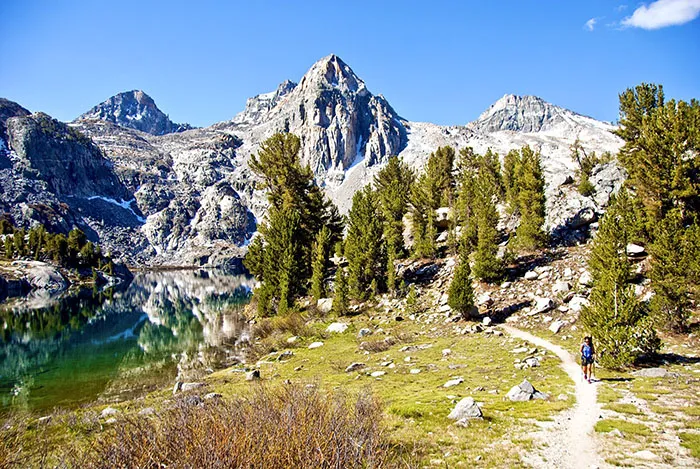Have you ever dreamed of an adventurous journey where you can immerse yourself in wild nature and witness the most majestic landscapes in America? The John Muir Trail (JMT) in California is the perfect destination, promising unforgettable experiences. Spanning over 211 miles (approximately 340 km) through the heart of the Sierra Nevada mountains, the JMT is not only a physical challenge but also a journey to explore the exquisite beauty of nature.
Overview of the John Muir Trail
The John Muir Trail is a renowned hiking trail stretching 211 miles through the central Sierra Nevada of California. This route traverses three national parks: Yosemite, Sequoia, and Kings Canyon, and conquers peaks over 14,000 feet (over 4,200 meters). Named after John Muir, a famous naturalist, writer, and conservationist who played a significant role in preserving the pristine beauty of the Sierra Nevada, the JMT is a tribute to his legacy.

Starting from Yosemite Valley and ending near Mount Whitney, the highest point in the contiguous United States, the JMT offers hikers the chance to relish pristine lakes, breathtaking waterfalls, ancient forests, and snow-capped peaks year-round.
Thorough Preparation for Conquering the JMT
Conquering the JMT is a demanding challenge, requiring thorough preparation in terms of fitness, skills, and equipment.
Building Physical Fitness
The diverse terrain of the JMT, with continuous ascents and high altitudes, demands a solid fitness foundation. Begin training at least a few months before the trip, focusing on exercises that enhance endurance, strength, and resilience.
Equipping with Necessary Skills
Besides physical fitness, equipping yourself with essential skills is crucial to dealing with unforeseen situations on the trail, such as first aid, navigation using a map and compass, natural survival skills, and weather knowledge.
Choosing Suitable Equipment
Selecting the right equipment also plays a vital role in ensuring a safe and comfortable trip. Here are some necessary items:
- Backpack: Choose a backpack that fits well and is large enough to hold all the essential items.
- Tent: Opt for a lightweight, easy-to-set-up tent with good weather resistance.
- Sleeping Bag: Select a sleeping bag that provides adequate warmth in low temperatures.
- Sleeping Pad: Choose a comfortable sleeping pad to ensure a good night’s rest after a long day of hiking.
- Hiking Boots: Choose comfortable hiking boots with good traction and ankle support.
- Clothing: Pack layered clothing for easy adjustments to the weather.
- Food: Bring enough food for the entire journey, including energy-rich, easy-to-digest, and non-perishable items.
- Water Supply: Carry enough water or a water filter to ensure adequate hydration.
- Map and Compass: For navigation along the trail.
- First Aid Kit: For treating minor injuries or emergency situations.
- Sun Protection: Sunscreen, hat, and sunglasses to protect against the sun’s harmful rays.
- Insect Repellent: To prevent insect bites.
Thorough preparation with appropriate equipment is crucial for successfully conquering the JMT. Ensure you have everything needed for a safe and enjoyable trip.
Important Notes When Exploring the JMT
- Best Time to Visit: Late July to early September is the ideal time to explore the JMT, with warm weather, little rain, and minimal snow.
- Permits: You’ll need a permit to hike the JMT. Securing a permit can be challenging, so plan ahead and apply early.
- Environmental Protection: Always be mindful of protecting the environment throughout your journey. Avoid littering, polluting water sources, and disturbing the local ecosystem.
- Safety: Adhere to safety guidelines and exercise caution in all situations. Monitor weather forecasts and be prepared for sudden changes.
Highlights Along the John Muir Trail
The JMT is a treasure trove of stunning natural landscapes. Here are some highlights not to be missed:
- Yosemite Valley: One of California’s most famous destinations, renowned for its spectacular granite cliffs, breathtaking waterfalls, and lush forests.
- Half Dome: An iconic symbol of Yosemite, known for its unique shape and panoramic views over the valley.
- Tuolumne Meadows: A vast meadow area situated at over 8,600 feet, featuring winding streams and granite mountain surrounds.
- Mount Whitney: The highest peak in the contiguous United States, offering breathtaking views of the entire Sierra Nevada.
Magnificent view from the top of Half Dome looking down into Yosemite Valley. An unmissable experience when conquering the JMT.
Conclusion
Exploring the John Muir Trail is a challenging yet immensely rewarding experience. If you’re someone who loves nature, enjoys mountain climbing, and seeks to push your limits, the JMT is a destination not to be missed. Prepare thoroughly, plan meticulously, and savor every moment on the journey through the wild beauty of the Sierra Nevada. Are you ready for this adventure of a lifetime?